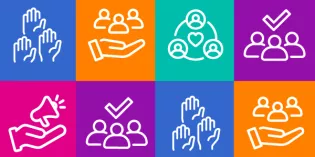
Dr Ronny Cheung, General Paediatrician, Evelina London Children's Hospital and RCPCH Officer for Health Services
Dr Mike McKean, Consultant Respiratory Paediatrician, Great North Children’s Hospital and RCPCH Vice President for Health Policy
What is Martha’s Rule?
Martha’s Rule aims to empower all staff, patients and their families to seek an independent medical review if they feel their concerns about a patient’s care are not being adequately addressed. Named after Martha Mills, a 13-year-old girl who tragically died in 2021 following missed opportunities to treat sepsis, the rule is being introduced to ensure better safeguards against preventable harm in healthcare settings.
The rule is designed to give families the ability to directly request an expert review by a senior clinician not within the immediate care team, potentially identifying critical issues before they result in harm.
In May 2024, NHS England announced the testing of Martha’s Rule in 143 pilot sites across the country, with the intention of adopting Martha’s Rule to all sites in England over the coming years. So far, approximately half of the pilot sites have included paediatric wards in their scope.
Martha’s Rule consists of three separate but related parts:
- Patients (or families/carers) will be asked, at least daily, about how they are feeling, and if they are getting better or worse, and this information will be acted on in a structured way.
- All staff will be able, at any time, to ask for a review from a different team if they are concerned that a patient is deteriorating, and they are not being responded to.
- This escalation route will also always be available to patients themselves, their families and carers and advertised across the hospital.
By establishing this right to an independent review, Martha’s Rule improves our ability to recognise and respond to deterioration by incorporating parents and families as part of the team. It formalises an escalation route for parents, carers and families to use to ensure their concerns are listened to and acted on and encourages transparency and collaboration. Similar schemes, such as Queensland’s Ryan’s Rule in Australia, have demonstrated they can have a real positive impact on patient safety and outcome.
How will it affect service delivery?
Engagement events held up and down the country over the past year have identified some common themes. For example, there are concerns that patients or families will use it to raise non-urgent issues, overwhelm the system with unnecessary requests, or treat it as a platform for general complaints rather than focusing on critical care concerns. Another worry is that Martha’s Rule might undermine clinicians’ authority or professional judgement, potentially creating adversarial relationships between patients and healthcare staff.
In fact, evidence from similar systems, such as Ryan’s Rule show that the majority of calls are genuine requests relating to escalation, made when patients or families noticed signs of deterioration that had been overlooked. Independent reviews confirm the validity of the concerns raised, with only a small percentage of calls being deemed unnecessary. Rather than causing friction, systems like Martha’s Rule have been shown to foster trust between patients and clinicians by creating an additional safety net, ensuring that serious concerns are heard and acted upon without undermining the overall authority or expertise of medical professionals.
This has been borne out by early data from NHS England’s pilot sites. Many sites have implemented solutions which involve an early triage point, so that enquiries can be screened and then directed to the right (often non-urgent) pathway. It is worth noting that these are still important calls: many relate to legitimate concerns over communication or other crucial issues relating to care quality. The evidence so far suggests that a significant number of activations (approximately 20%) have really changed the trajectory of care - but dealing with these other queries still takes time and consideration.
Notably, 10% of the total activations have come, not from patients and families, but from staff. This is hugely significant, because it shines a light on issues around the culture of the workplace, psychological safety, clinical hierarchy and systems of care that exist not just between patients and staff, but within the clinical teams themselves – something that perhaps, without Martha’s Rule, would have remained hidden for much longer.
Concentrating on how marginalised and disadvantaged groups access Martha's Rule is a priority
Inequality of access is another concern. This is, after all, a system which favours patients and families who speak English as a first language, are actively engaged in their care, and feel more able to overcome a perceived power imbalance and articulate their concerns to staff. Traditionally such interventions have resulted in further entrenching disadvantage based on deprivation, educational attainment, ethnicity and health literacy. The NHS pilot is actively collecting data on this: so far Martha’s Rule does not appear to be overt detrimental to the more vulnerable or disadvantaged patient groups, although it is too early to be conclusive. Concentrating on how marginalised and disadvantaged groups access this intervention is a priority.
How will this work for children?
It is helpful to remember that this is not a standalone initiative but part of a system response to recognising and acting on potential early deterioration. The first part of the rule to ask patients and families how they feel daily, has been part of paediatric care using parent and family concern for a long time across the UK. The standardisation of Paediatric Early Warning Systems will support routine and objective recognition of deterioration. The inpatient national tool launched across England in November 2023, explicitly includes the expectation that the views of parents and carers (and soon, children and young people themselves) be sought and acted on in a structured way. Similar programmes with explicit expectations of parental and carer triggered escalation are already in place in Scotland and Northern Ireland and are soon to rolled out across Wales.
Martha’s Rule will build on these escalation systems to add the ability for parents, carers or patients to escalate concerns in parallel to these systems. There are special considerations to making sure this works for children and young people. While most adult patients in acute hospital settings will have access to face-to-face critical care expertise, this is not routinely the case in paediatrics, due to the way paediatric critical care is organised. Some pilot sites have set up pathways where different paediatric teams are able to provide reciprocal support with urgent reviews. Others with the right blend of skills have set up pathways which allow predominantly adult-focused critical care colleagues to provide urgent escalation reviews for children provided they are appropriately trained.
For any model, virtual support and advice from paediatric critical care networks are likely to be crucial - indeed these models will be explicitly tested in the three paediatric critical care networks which are taking part in the pilots. Support for neonates is similarly a conundrum: while similar critical care network approaches may work, there are potentially more limited options when it comes to “in-house” shared expertise. The RCPCH policy and patient safety teams remain actively involved in the design process for this, and will represent member views in these important discussions.
Much of the design and delivery of the pilot programme has been centred around the needs of adult patients...
Another challenge lies in tailoring the response system to accommodate the diverse needs of paediatric patients. Children, particularly younger ones, may not be able to communicate their symptoms effectively, requiring families to interpret signs and rely on instinct. While the patient voice has been strongly present in the design and delivery of the NHS England pilot programme, much of this has been centred around the needs of adult patients, or adults who are parents or carers of children and young people. Some centres, like the Great North Children’s Hospital in Newcastle, have taken the initiative and started asking older children and young people themselves, about what they expect Martha’s Rule to do for them, and how they would want to be able to articulate concerns over their own care. We will devote another blog in the coming months to hear what they have to say.
The pilot sites will be reporting on preliminary findings over the course of the year. You can keep in touch with updates on our Martha's Rule guidance page and see the NHS England page. We will also keep you up to date in future Safety eBulletins (archived versions found here).
Final thoughts
So much of the work on implementing Martha’s Rule has been focused on clinical and operational processes, it is easy to forget that, like all large-scale healthcare innovations, this is not just a technical change but predominantly a change in beliefs and organisational culture (what the leadership academic Ron Heifetz calls “socio-adaptive” change). There is no doubt that a Martha’s Rule escalation will engender an emotional, often challenging response for the responsible clinicians. Acknowledging that that is a normal human reaction is an important step to helping us to build a culture that transcends that. Evidence of effectiveness (such as from Ryan’s rule or early NHS pilot data) will surely help to sway clinicians as to the potential power it can have to flatten hierarchies and improve clinical safety culture, far beyond the effect of the specific technical intervention itself.
Finally – you can learn more at the RCPCH Conference in Glasgow in March, where one of our keynote speakers will be Professor Nitin Kapur, President of Paediatrics and Child Health at the Royal Australian College of Physicians and a pioneer of Ryan’s Rule, who will shine a light on the paediatric experience in Queensland over the past decade. Look forward to seeing you there!
For more information on safety in paediatrics and child health, please visit our Patient Safety Portal. And look out for our Safety eBulletin, which are emailed every two months to members opted in get College updates (you can check your contact preferences on your online account).










